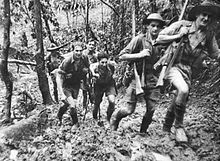8°59′10″S 147°44′08″E / 8.986222°S 147.735556°E
| Battle of Isurava | |||||||
|---|---|---|---|---|---|---|---|
| Part of the Second World War, Pacific War | |||||||
 Members of the 39th Battalion withdrawing after the Battle of Isurava | |||||||
| |||||||
| Belligerents | |||||||
|
|
| ||||||
| Commanders and leaders | |||||||
|
|
| ||||||
| Units involved | |||||||
| Strength | |||||||
| 2,290 | 2,130 | ||||||
| Casualties and losses | |||||||
|
99 killed 111 wounded |
140 killed 231 wounded | ||||||
The Battle of Isurava, also sometimes referred to as the Battle of Isurava – Abuari[1] or the Battle of Isuraba,[2] took place between 26 and 31 August 1942. Forming part of the Kokoda Track campaign of the Second World War, the battle involved military forces from Australia, supported by the United States, fighting against Japanese troops from Major General Tomitaro Horii's South Seas Detachment, who had landed around Buna and Gona in Papua mid-July 1942, with the intent of capturing Port Moresby to the south, via the overland route.
Several small engagements were fought north of Kokoda, before the village itself became the scene of heavy fighting as the Australian Maroubra Force fought to delay the Japanese advance throughout late July and into early August. After further fighting around Deniki, the Australians withdrew to Isurava, where the Militia soldiers of Maroubra Force were reinforced by two Second Australian Imperial Force battalions of the veteran 21st Infantry Brigade under Brigadier Arnold Potts.
In what became the first major battle of the campaign, the two sides fought a heavy engagement around Isurava in late August, as four Australian infantry battalions attempted to fend off attacks by a similarly sized Japanese force. On the other side of Eora Creek, clashes were fought around Abuari, as a Japanese battalion attempted to outflank the Australians at Isurava from the west, and cut the track around Alola, while another Japanese battalion attempted to flank Isurava to the west. Subjected to a heavy Japanese artillery bombardment, and lacking their own with which to counter this indirect fire, the Australians defended for four days, before conducting a withdrawal in contact, falling back towards Templeton's Crossing, which was the scene of further fighting in early September 1942.
In the years following the battle, the fighting around Isurava has come to form a key part of the Australian narrative of the campaign. The Japanese were victorious in capturing Isurava, but Australian accounts in the early years after the war characterised the battle as a successful delaying action by a heavily outnumbered force, that inflicted more casualties than it sustained, highlighting the bravery of Australian troops in an epic and desperate action of national survival. In this regard, the Battle of Isurava has come to form a key part of the Anzac legend, although recent accounts have re-examined the battle. As the size of the Japanese force committed to the fighting has been re-evaluated, the magnitude of the Australian defensive feat has also been reinterpreted. Recent analysis, while acknowledging the individual bravery of both Australian and Japanese soldiers, highlights tactical deficiencies on both sides, and now characterises the battle as one in which Australian forces were able to withdraw largely due to tactical errors from the Japanese commanders.
- ^ Anderson 2014, p. 51.
- ^ Tanaka 1980, p. 21.